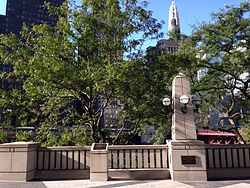History
Point du Sable likely settled near the mouth of the Chicago River sometime around the 1780s and sold the property in 1800. He lived here with his wife, Kitihawa, and children. The 1800 bill of sale was rediscovered in 1913 in an archive in Detroit, Michigan. [5] The property included a house, two barns, a horse drawn mill, a bakehouse, a poultry house, a dairy, and a smokehouse. Their house was a 22-by-40-foot (6.7 m × 12.2 m) log cabin filled with fine furniture and paintings. [5]
Following Point du Sable's departure from Chicago, the home became the property of John Kinzie. In 1834 the land owned by Kinzie was platted and sold. [6] The "Kinzie addition" to Chicago, which is assumed to be coterminous with Point du Sable's estate extended from the banks of the Chicago River north to Chicago Avenue, and from State Street east to Lake Michigan. [4]
Monument
A commemorative plaque, struck in 1937, was installed on a marble block at Pioneer Court after its 1965 dedication. It reads, "KINZIE MANSION / Near this site stood Kinzie Mansion, / 1784-1832, home of Pointe Du Saible, / Le Mai, and John Kinzie, Chicago's / "first civilian," here was born in 1805, / the city's first white child Ellen Marion Kinzie". [4] While the plaque is correct that Ellen Marion Kinzie was the first white child born in the city, Du Sable's granddaughter, Eulalie Pelletier, was the first non-native to be born in the city, in 1796. [4]
Pioneer Court was listed on the National Register of Historic Places and listed as a National Historic Landmark on May 11, 1976. [2] At this site in 2009 the City of Chicago and a private donor erected a large bronze bust of Point du Sable by Chicago-born sculptor Erik Blome. [7] In October 2010 the adjacent Michigan Avenue Bridge was renamed DuSable Bridge in honor of Point du Sable.
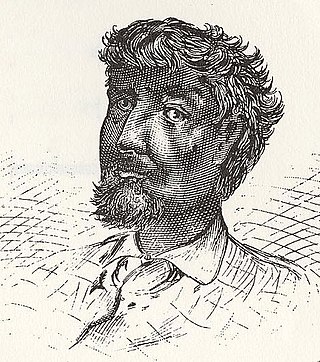
Jean Baptiste Point du Sable is regarded as the first permanent non-Native settler of what would later become Chicago, Illinois, and is recognized as the city's founder. The site where he settled near the mouth of the Chicago River around the 1780s is memorialized as a National Historic Landmark, now located in Pioneer Court.

Fort Dearborn was a United States fort, first built in 1803 beside the Chicago River, in what is now Chicago, Illinois. It was constructed by U.S. troops under Captain John Whistler and named in honor of Henry Dearborn, then United States Secretary of War. The original fort was destroyed following the Battle of Fort Dearborn during the War of 1812, and a replacement Fort Dearborn was constructed on the same site in 1816 and decommissioned by 1837.

The Chicago River is a system of rivers and canals with a combined length of 156 miles (251 km) that runs through the city of Chicago, including its center. Though not especially long, the river is notable because it is one of the reasons for Chicago's geographic importance: the related Chicago Portage is a link between the Great Lakes and the Mississippi River Basin, and ultimately the Gulf of Mexico.
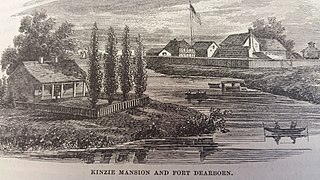
John Kinzie was a fur trader from Quebec who first operated in Detroit and what became the Northwest Territory of the United States. A partner of William Burnett from Canada, about 1802-1803 Kinzie moved with his wife and child to Chicago, where they were among the first permanent white non-indigenous settlers. Kinzie Street (400N) in Chicago is named for him. Their daughter Ellen Marion Kinzie, born in 1805, was not the first child of European descent born in the settlement. That title goes to Eulalia Pelletier, the granddaughter of Chicago's first permanent non-indigenous settler, Jean Baptiste Pointe DuSable.
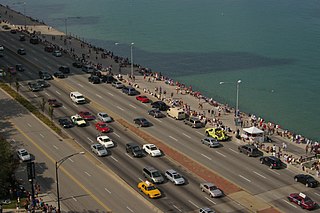
Lake Shore Drive is a semi-limited access expressway that runs alongside the shoreline of Lake Michigan and its adjacent parkland and beaches in Chicago, Illinois. Except for the portion north of Foster Avenue, the Drive is designated part of U.S. Highway 41. A portion of the highway on the Outer Drive Bridge and its bridge approaches is multilevel.

Streeterville is a neighborhood in the Near North Side community area of Chicago, Illinois, United States, north of the Chicago River. It is bounded by the river on the south, the Magnificent Mile portion of Michigan Avenue on the west, and Lake Michigan on the north and east, according to most sources, although the city of Chicago recognizes only a small portion of this region as Streeterville. Thus, it can be described as the Magnificent Mile plus all land east of it. The tourist attraction of Navy Pier and Ohio Street Beach extend out into the lake from southern Streeterville. To the north, the East Lake Shore Drive District, where the Drive curves around the shoreline, may be considered an extension of the Gold Coast. The majority of the land in this neighborhood is reclaimed sandbar.
Jean La Lime or Lalime was a trader from Quebec, Canada who worked in what became the Northwest Territory of the United States. He worked as an agent for William Burnett, also of Canada, to sell to the Native Americans and take furs in exchange. He was among the first European permanent settlers in Chicago. He was killed there in 1812, in what was called the "first murder in Chicago", by John Kinzie, a trading partner of Burnett who was another early settler from Canada.

The Magnificent Mile, sometimes referred to as The Mag Mile, is an upscale section of Chicago's Michigan Avenue, running from the Chicago River to Oak Street in the Near North Side. The district is located within downtown and one block east of Rush Street. The Magnificent Mile serves as the main thoroughfare between Chicago's Loop business district and its Gold Coast. It is generally the western boundary of the Streeterville neighborhood, to its east, and of River North to the west.

The DuSable Black History Museum and Education Center, formerly the DuSable Museum of African American History, is a museum in Chicago that is dedicated to the study and conservation of African-American history, culture, and art. It was founded in 1961 by Margaret Taylor-Burroughs, her husband Charles Burroughs, Gerard Lew, Eugene Feldman, Bernard Goss, Marian M. Hadley, and others. They established the museum to celebrate black culture, at the time overlooked by most museums and academic establishments. The museum has an affiliation with the Smithsonian Institution.
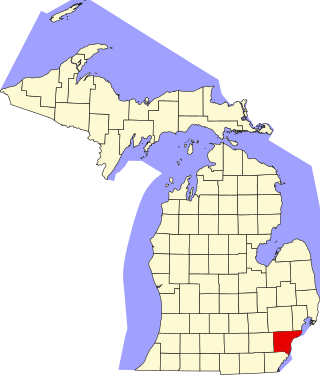
This is a list of the National Register of Historic Places listings in Wayne County, Michigan.
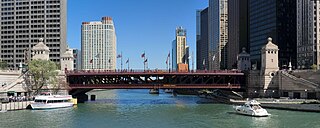
The DuSable Bridge is a bascule bridge that carries Michigan Avenue across the main stem of the Chicago River in downtown Chicago, Illinois, United States. The bridge was proposed in the early 20th century as part of a plan to link Grant Park (downtown) and Lincoln Park (uptown) with a grand boulevard. Construction of the bridge started in 1918, it opened to traffic in 1920, and decorative work was completed in 1928. The bridge provides passage for vehicles and pedestrians on two levels. An example of a fixed trunnion bascule bridge, it may be raised to allow tall ships and boats to pass underneath. The bridge is included in the Michigan–Wacker Historic District and has been designated as a Chicago Landmark.

The Big Bureau Creek is a 73-mile-long (117 km) tributary of the Illinois River in north central Illinois. It rises approximately 10 miles (16 km) north of Mendota and flows southwest into Bureau County, turning south at Princeton and then flowing east into the Illinois River floodplain. Among the creek's more notable features is the Red Covered Bridge, built in 1863, which passes over Big Bureau Creek and was once part of the Peoria Galena Trail. The bridge, located just north of Interstate 80, is listed on the National Register of Historic Places.
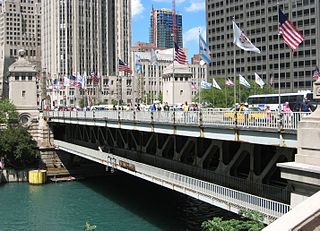
Pioneer Court is a plaza located near the junction of the Chicago River and Upper Michigan Avenue in Chicago's Magnificent Mile. It is believed to be the site of Jean Baptiste Point du Sable's original residence and trading post. In 1965, the plaza was built on the former site of his homestead as part of the construction of the Equitable Life Assurance Society of America building. The Jean Baptiste Point Du Sable Homesite was designated as a National Historic Landmark on May 11, 1976. John Kinzie, a prominent early settler, bought and expanded Point du Sable's post in 1800. The Plaza is bounded on the north by the Tribune Tower, on the east by 401 N. Michigan Avenue, on the south by the Chicago River, and on the west by Michigan Avenue, adjacent to the DuSable Bridge. In 2017, a newly designed Apple Inc. store was opened on the south side of the court, which created new levels linking down to the river.

The Chicago and North Western Railway's Kinzie Street railroad bridge is a single leaf bascule bridge across the north branch of the Chicago River in downtown Chicago, Illinois. At the time of its opening in 1908 it was the world's longest and heaviest bascule bridge. The previous bridges on the same site included a pedestrian span that was the first bridge across the Chicago River; a second bridge that served as Chicago's first railroad bridge; and a third bridge that was one of the first all-steel spans in the United States.

The Michigan–Wacker Historic District is a National Register of Historic Places District that includes parts of the Chicago Loop and Near North Side community areas in Chicago, Illinois, United States. The district is known for the Chicago River, two bridges that cross it, and eleven high rise and skyscraper buildings erected in the 1920s. Among the contributing properties are the following Chicago Landmark structures:
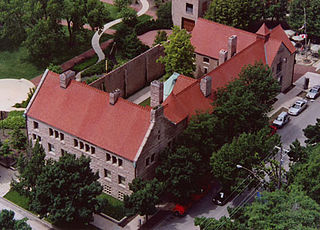
Prairie Avenue is a north–south street on the South Side of Chicago, which historically extended from 16th Street in the Near South Side to the city's southern limits and beyond. The street has a rich history from its origins as a major trail for horseback riders and carriages. During the last three decades of the 19th century, a six-block section of the street served as the residence of many of Chicago's elite families and an additional four-block section was also known for grand homes. The upper six-block section includes part of the historic Prairie Avenue District, which was declared a Chicago Landmark and added to the National Register of Historic Places.

401 North Michigan is a 35-story skyscraper in the Streeterville area of Chicago, built in 1965 at 401 North Michigan Avenue, along the north bank of the Chicago River. It was designed by Bruce Graham and Natalie de Blois in the international style. Along with the Tribune Tower and Wrigley Building, it forms the southern gateway to Chicago's famous Magnificent Mile. The building was built atop the site of a cabin belonging to Chicago's first permanent resident, Jean Baptiste Pointe du Sable. In reference to du Sable, the large plaza adjacent to the building has been named Pioneer Court.

The John W. Griffiths Mansion is a historic house at 3806 S. Michigan Avenue in the Douglas community area of Chicago, Illinois. The house was built in 1893-94 for John W. Griffiths, a prominent building contractor who worked in Chicago during its reconstruction after the Great Chicago Fire. Architect Solon Beman designed the Chateauesque house, which features a limestone-clad exterior, an octagon-shaped tower on its northeast corner, corbels along the roof line, and dormers topped with finials. The house was typical of those on Michigan Avenue at the time, as many affluent Chicagoans built their homes there; it was also one of the last such homes, as the Panic of 1893 and industrial development led the area to lose its popularity with the wealthy. After Griffiths died in the 1930s, the home became the meeting place of the Quincy Club, a social club for black railroad workers. It later became the first home of the DuSable Museum of African American History.

A bronze bust of Jean Baptiste Point du Sable by Erik Blome is installed in Chicago, in the U.S. state of Illinois.
